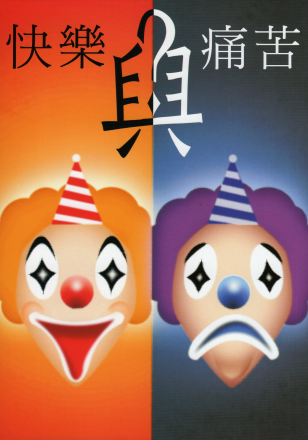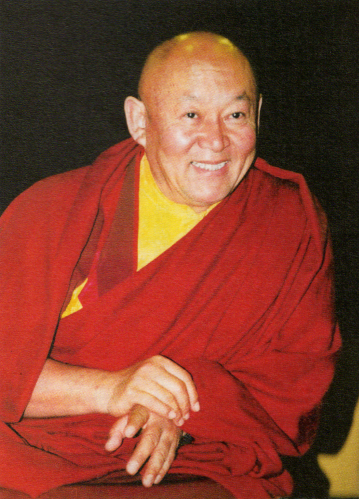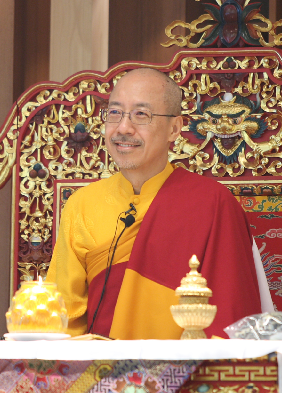The His Eminence Rinchen Dorjee Rinpoche’s marvelous book entitled with “Happiness and Suffering” of Chinese edition has been published in September, 2009. Up till the present, this book has been accepted to keep in the Library of Congress of the United States, Harvard-Yenching Library of Harvard University, C.V. Starr East Asian Library of Columbia University, Kroch Library of Cornell University, Milton S. Eisenhower Library of Johns Hopkins University, Humanities Library of Massachusetts Institute of Technology and C.V. Starr East Asian Library of University of California at Berkeley, and Bodleian Library Of Oxford Univseristy, UK. Rinchen Dorjee Rinpoche is endowed with great mercy and compassion and Bodhichitta that all of his words and deeds are to benefit sentient beings. Rinchen Dorjee Rinpoche wishes that this book could help people eliminate their afflictions, and obtain the bliss by understanding the essence of happiness and suffering of the daily life.
Prior to writing this book, Happiness and Suffering, Rinchen Dorjee Rinpoche has implored his root guru His Holiness Drikung Kyabgon Chetsang for H.H.’s advice and foreword. His Holiness granted Rinchen Dorjee Rinpoche’s pleading since His Holiness realized immediately after reading this book that it is a language prajna. His Holiness’ grant of his writing the foreword for Rinchen Dorjee Rinpoche is a blessing which symbolizes Buddhas and Bodhisattvas’ recognition that this book would benefit sentient beings. Therefore the reason why everyone can have so much gain from these simple words of this book is because of the blessings from Buddhas, Bodhisattvas and the Drikung lineage.
In this book, Rinchen Dorjee Rinpoche does not talk about rare Buddhism terms and abstruse philosophies. Instead, Rinchen Dorjee Rinpoche lively leads the reader to know the true essence of happiness and suffering by Rinchen Dorjee Rinpoche’s experiences of accordingly applying Buddha Dharma in daily life assisted with rich examples. Rinchen Dorjee Rinpoche not only carefully edits the contents of this book, but also personally designs the cover of the book that implies profound states and meanings of the practice. Likewise, the contents of two hundred forty pages of this book are concise with deep meaning. This book has obtained tremendous response since it published. Besides disciples, no matter who you are a Buddhist or not, many people gain immense benefit and the wisdom nectar from the great practitioner and make themselves face all daily life’s happiness and suffering with more healthy and correct attitude. Up till recently, this book has sold more than 15 thousand copies.
A brief introduction to this book is as followed.
 |
◎ Author: Rinchen Dorjee Rinpoche ◎ Dimensions: 14.8 x 21 cm ◎ Number of Pages: 240 ◎ Mono/Color Printing: Mono ◎ Binding: Paperback ◎ ISBN-13: 978-986-85606-0-4 ◎ Date of Publish: September 2009 ◎ Publisher: Glorious Jewel Co. Ltd. ◎ Language: Chinese |
About the Author

About the Author
Rinchen Dorjee Rinpoche
In 1985, Rinchen Dorjee Rinpoche, at age 37, had an urge to vomit at the sight of meat after paying a visit to Master Guang Qin, and therefore adopted a vegetarian diet thereafter. In 1986, Rinchen Dorjee Rinpoche sought refuge in Master Jinneng of Exoteric Buddhism and began his studies in exoteric Buddhist sutras, attending repentance ceremonies sincerely, making prostrations to the Buddhas, and dedicating himself to supporting monasteries and various Buddhist activities. In1988, Rinchen Dorjee Rinpoche sought refuge under His Holiness The 37th Drikung Kyabgon Chetsang of Tibetan Buddhism and became His Holiness’s root disciple. In 1997, Rinchen Dorjee Rinpoche founded the Glorious Jewel Buddhist Center in Taipei and thereafter has been holding Chod pujas and regular pujas on a regular basis for the benefit of all sentient beings. In 1999, Rinchen Dorjee Rinpoche was officially recognized by His Holiness Dirkung Kyabgon Chetsang in public as the only ngakpa Drikung Guru of Han people in the Drikung Kagyu Order in an enthronement ceremony held at Jangchubling Monastery, India. In 2007, His Holiness Drikung Kyabgon Chetsang instructed Rinchen Dorjee Rinpoche to perform a three month retreat in the snowy mountains of Lapchi, Nepal, where Jetsun Milarepa, a lineage guru, had performed retreats. That the guru and his disciple conducted retreats simultaneously in their retreat rooms adjacent to each other symbolize the inseparability of guru-disciple relationship in Dharma activities. Rinchen Dorjee Rinpoche is the first in the history of the Drikung tradition to have perfected the practice of Hevajra in retreat under the guidance of Drikung Kyabgon. Upon completion of the retreat, His Holiness endowed Rinchen Dorjee Rinpoche with an auspicious ordain name “Rinchen Dorjee Rinpoche” which means “Most Precious Treasure Vajra Rinpoche”.
Being the first ngakpa guru of Han people in Tibetan history, Rinchen Dorjee Rinpoche was born into a family where Taoism had been revered and practiced. Nevertheless, at age 18, Rinchen Dorjee Rinpoche faced his father’s death and realized that no solutions in any Taoist practices could be found to deal with such an important affair about life and death in one’s life. Thereby, with determination, Rinchen Dorjee Rinpoche initiated his quest for a method to truly liberate oneself from the cycle of birth and death, to leave sufferings, and to obtain happiness. Eventually, since meeting Master Guang Qin at age 37 and seeking refuge in His Holiness Drikung Kyabgon Chetsang at 40, Rinchen Dorjee Rinpoche has practiced Buddhism constantly and diligently, perfected 8 retreats, dedicated himself to supporting the Lineage, and achieved his attainment with true realizations and practice. In the past dozen years, Rinchen Dorjee Rinpoche has benefited innumerable sentient beings in the universe that were not liberated or got physical sufferings from incurable diseases and psychological sufferings from worldly afflictions. Again and again, Rinchen Dorjee Rinpoche teaches all of his disciples and believers by the example of his own experiences in practice and orthodox Buddhist teachings. Since Rinchen Dorjee Rinpoche was able to achieve his attainment as an ordinary human being, anyone who has the determination will definitely be able to do so. More importantly, Rinchen Dorjee Rinpoche teaches us how to incorporate the Buddhist teachings into our daily lives in this modern society as well as how to conduct lay practice without being mentally confused by the intricate commercial society.
Recommendation Foreword in Tibetan by His Holiness The 37th Drikung Kyabgon Chetsang

Rinchen Dorjee Rinpoche, a disciple of Drikung Kagyu and the founder of the Glorious Jewel Buddhist Center in Taipei, has been piously supporting the Drikung Kagyu Lineage all the time. Recently, Rinchen Dorjee Rinpoche has published a book called Happiness and Suffering. The book introduces the essence of the Buddhist teachings in concise and comprehensible words that are easy to understand.
In the book, the provided insights from the Buddhist perspective will definitely help and benefit Buddhist cultivators who try to solve problems in their daily lives. Additionally, it includes contents of practices in both common and uncommon vehicles. The included common practices are: the optimum human form that is hard to achieve, the impermanence of birth and death, the karmic force and the law of cause and effect, the sufferings of reincarnation, and the practice of compassion and cultivation of Bodhichitta in Mahayana. The included uncommon practices are: the immeasurable piety and esteem towards a tantric guru in Vajrayana, the recitation and visualization of the non-dual practice of Mahamudra, and most of the important practice means, especially the experiences derived from self-practice of the Buddhist teachings.
The meaning of this book lies in that it can solve problems that the disciples encounter in their real lives nowadays and guide people with the Buddhist teachings so that they know how to face their practice and life in reality.
May the publication of this book help readers to eliminate all the obstacles against their Buddhist activities so that they accomplish their Buddhist path perfectly and successfully to gain the liberation.
Written in the sacred place of Jangchubling
Blessed with name of the victorious Drikungpa by Konchog Tenzin Kunsang Thrinle Lhundrup (Drikung Kyabgon) on July 25th, 2009, the Year of Earth Ox in the Tibetan Calendar
About His Holiness The 37th Drikung Kyabgon Chetsang

His Holiness The 37th Drikung Kyabgon Chetsang
His Holiness Drikung Kyabgon Chetsang, the 37th throne holder of the Drikung Kagyu Lineage, has been the reincarnation of the 23rd, 25th, 27th, 29th, 32nd and 34th throne holder of Drikung Kagyu Lineage and is also one of the four major throne holders that are generally recognized by the Four Major Schools of Tibetan Buddhism, namely Nyingma, Kagyu, Sakya and Gelugpa. His Holiness Drikung Kyabgon Chetsang was born in the Tibetan month of the Fire-Dog-Year 1946 into the aristocratic family of Tsarong in Lhasa, Tibet. This auspicious day marks the anniversary of the Buddha’s first turning of the Wheel of Dharma at Deer Park.
1949, at the age of three, based on a vision of the Drikung Regent Tritsab Gyabra Tenzin Thupten Rinpoche at the oracular lake Lhamo Latso, the son of the Tsarong family was officially recognized as the reincarnation of the Drikung Kyabgon. This is the 7th reincarnation of the Chetsang Rinpoche. Experienced through the changes of political situations such as the Cultural Revolution, His Holiness peacefully got through the difficult time with his compassion, wisdom and patience. Since 1987 His Holiness began to give teachings in many countries throughout the world. At the same time he established the Drikung Kagyu Institute and an educational center in Jangchubling, India for monks’ education and Drikung Kagyu lineage traditions’ continuance.
In 2003 His Holiness established the Songtsen Library, the only one that of the Buddhist digital collection among the Four Major Schools of the Tibetan Buddhism. The library is equipped with modern facilities reaching the world advanced level so as to reserve the Tibetan culture, historical sutras and the Buddhist treasures of the Buddha’s time, in hope of having orthodox Buddhism widely prevail in the world and benefit more sentient beings through the tradition in the future.
Preface by the Author

Rinchen Dorjee Rinpoche
Beginning as an ordinary believer, I have attained accomplishment in this life through true practices, and was recognized as a Ngakpa Guru of Han people by my root Guru, His Holiness The 37th Drikung Kyabgon Chetsang.
Since I well-understood with human affair, I had experienced several kinds of worldly sorrow and happiness before starting to learn and cultivate Buddha-Dharma. My father passed away when I was teenager. I ever worked at a kitchen of a hotel. I also had achieved great success in business, but it was followed by peak-to-trough falling with a loss of ten millions of dollars. I once was too poor to have meals. Moreover, fortunetellers predicted that I could only live until age forty-five at most. Being a lay practitioner, I also experienced the illness such as pains of my S-shaped Scoliosis, the lesion changes of my skin cancer on face and so forth. These experiences make me realize lay people’s sorrow and happiness more deeply.
Through my personal experience of Buddhist practice and life, I recognize that many worldly methods and theories cannot thoroughly resolve all kinds of sufferings in the world, nor let people abstain from the continuous desires of pursuing enjoyment.
Therefore, through accordingly applying Buddha-Dharma in my daily life, I particularly choose the method of “sorrow and happiness” among several Dharma practices for that everyone would definitely have these experiences in this life. It is hoped that through my humble opinions, people in suffering would be liberated, and those who are pursuing happiness but unsatisfied and who are always expecting, clinging and indulging in enjoyment would understand and realize the true nature of happiness.
Table of Content
|
Foreword |
|
Part 4 |
Originate from the Mind |
|
Preface by the Author |
|
Cultivate Positive Notions and Attitudes |
|
|
Part 1 |
Happiness and Suffering |
|
The Spirits Affect the Physical Body |
|
|
The Suffered Human Life |
|
The Discriminating Mind |
|
|
The Origin of Suffering |
|
The Contributions of the Emperor Yang of Sui |
|
|
Is Suffering useless? |
|
The Mind Mara |
|
|
Suffering is Useful |
|
Direct One’s Own Mind |
|
|
Unfair |
|
The Mind Transcends the Phenomena |
|
|
Accept the Suffering |
|
Was Su Dongpo Unmoved by the Eight Winds? |
|
|
Do I Have Severe Karma? |
|
The Ordinary Mind |
|
|
Make 500 Times of the Full Prostration |
|
Find out Problems in the Mind |
|
|
Treat Anyone Else Well Without Regard to Oneself |
|
Happiness Comes from the Mind |
|
|
The Realization of a Retreat in India |
|
The Bodhimind |
|
|
The Attachment to Our Own Ego |
|
Be a Soft but Firm Heart |
|
|
Free from Self-centered |
|
A Mind Toward Buddhahood |
|
|
Take Suffering in Place of the Sentient Beings |
Part 5 |
The Training for Mercy and Compassion Heart |
|
|
The Suffering is Generated by Thinking |
|
Cultivating Mercy and Compassion Heart |
|
|
Is Obtainment a Joy? |
|
Mercy and Compassion Is Developed by Training |
|
|
Happiness Is Not a Good Thing |
|
Start Learning Mercy and Compassion from the Sense of Taste |
|
|
Antipathy From Happiness |
|
|
|
|
Happiness Follows Contentment; Suffering Follows Discontentment |
|
The Power of Mercy and Compassion |
|
|
Make Other People Happy |
Part 6 |
The Right Mind-Set of a Buddha’s Disciple |
|
Part 2 |
The Human Body; the Human Life |
|
Intrusion by Evil Spirits |
|
|
The Human Body is Difficult to Obtain |
|
The Proper Meditating and Sitting Still |
|
|
The Ties of Kinship |
|
Good Deeds are to Practice the Bodhisattva’s Path |
|
|
Parted from the Beloved Ones |
|
Stay Away from Evil Companions |
|
|
A Dead-Alive Person |
|
Free from Life and Death |
|
|
The Physical Body is Delusive |
|
The Four Kinds of Power |
|
|
Let Go the Happiness and Suffering |
|
May the Effect Retribution of the Beings Turn into Maturation upon Me |
|
|
Happiness Can Be Found Without Seeking |
|
The Incomparable Moral Courage |
|
|
Devotedly Practice Good Deeds |
|
The Origin of Learning Buddhism |
|
|
Giving and Patience |
|
Looking for the Helpful Guru |
|
|
Living with Conditions |
|
The Guru is of Paramount Importance |
|
|
Life is Impermanent |
|
Blessings |
|
|
Confront the Death |
|
Charities and Offerings |
|
Part 3 |
Reincarnation & Cause and Effect |
|
The Significance of Pujas |
|
|
Will a Good Return Follow Good Deeds? |
|
Opportunities to Learn Buddhism |
|
|
A Hypocritical Nice Person |
|
Are Prosperous Individuals Less Likely to Choose the Path of Cultivation? |
|
|
My Younger Brother’s Cerebral Hemangioma |
|
Joy as a Manifestation of the Buddha-Dharma |
|
|
Something Behind a Run of Bad Luck? |
|
The Bliss |
|
|
The Symbiotic Nature |
|
Smiley Buddha Statues |
|
|
The Immense Suffering |
|
The Clinging to Liberating the Beings from Reincarnation |
|
|
Reincarnation Accompanies the Emotion |
|
Ceaselessly Learn Buddhism |
|
|
Free from Reincarnation |
|
Dignified Death |
|
|
|
Epilog |
|
|
|
|
|
Buddha’s Teachings Inspired Us |
Updated on January 8, 2010